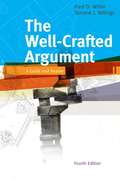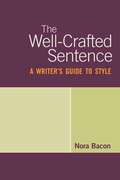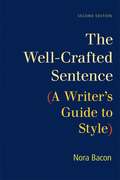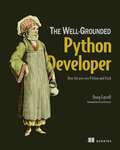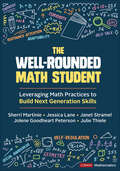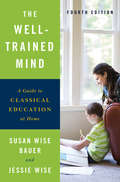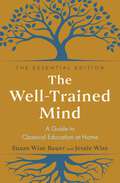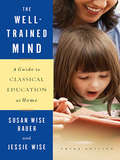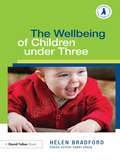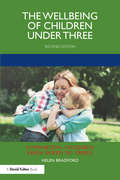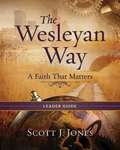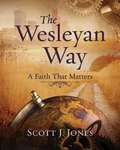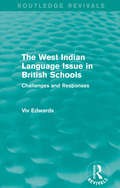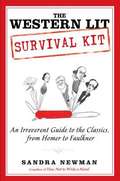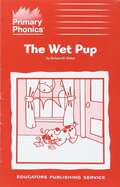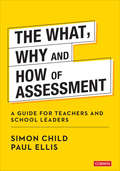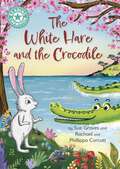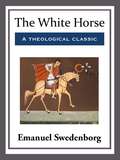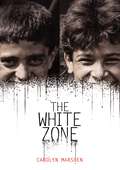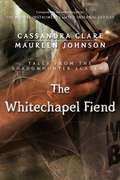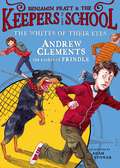- Table View
- List View
The Well-Crafted Argument: A Guide and Reader (4th Edition)
by Fred D. White Simone J. BillingsIncorporating new articles, expanded commentary, and the latest changes from the 2009 MLA Handbook and 2009 APA Publication Manual, the 4th Edition of THE WELL-CRAFTED ARGUMENT guides students through the process of writing effective arguments across the disciplines. The two-part structure of this rhetoric/reader includes a complete pedagogical apparatus--with coverage of critical reading strategies, as well as writing, researching, and documenting a topic--and an anthology of readings grouped into nine thematic clusters. In-depth instruction, combined with real student writings, engages students and helps them discover their own voices. The Fourth Edition continues the visual emphasis from the 3rd Edition, while maintaining the authors' practical, skill-building approach. Each chapter in Part I ends with a "Summary," "Checklist," and "Writing Projects," while each cluster in Part II ends with "Connections Among the Clusters," "Writing Projects," and "Suggestions for Further Reading. " These sections encourage students to apply what they've learned and go beyond the classroom if a topic is of particular interest to them. In addition to guidance on drafting and revising arguments, the authors provide a variety of composition strategies, including freewriting, outlining, and shared reading.
The Well-Crafted Sentence: A Writer's Guide to Style
by Nora BaconThe Well-Crafted Sentence is designed to help undergraduates develop facility in writing smooth, clear, fully developed sentences. It is not a grammar book: it does not focus on avoiding or correcting errors, and it makes no attempt to offer a thorough description of English syntax. Instead, it asks students to examine prose written by accomplished stylists, to note the relationship between syntactic structures and their rhetorical effect, and to practice using specific structures that all adult writers can, but only the best writers often do, take advantage of in their work.
The Well-Crafted Sentence: A Writer's Guide to Style (2nd Edition)
by Nora BaconGrounded in the art of writing, The Well-Crafted Sentence zeroes in on the building block of great prose: the sentence. With a friendly, approachable, and elegant tone, Nora Bacon shows the benefits of attention to style and offers a range of revision strategies that give students the tools to strengthen and develop their writing. Giving students the opportunity to see successful rhetorical choices at work in writing they admire, the text includes a brief anthology of readings by ten accomplished stylists, five of them new to this edition. Examples throughout the text are drawn from these model pieces, as are integrated exercises that help students apply concepts to their own writing. Additionally, a new first chapter, Approaches to Style, introduces students to the concept of style. Affordable and brief, The Well-Crafted Sentence works as a core classroom text or as a supplement.
The Well-Grounded Python Developer: How the pros use Python and Flask
by Doug FarrellIf you&’re new to Python, it can be tough to understand when, where, and how to use all its language features. This friendly guide shows you how the Python ecosystem fits together, and grounds you in the skills you need to continue your journey to being a software developer.Summary Inside The Well-Grounded Python Developer you will discover: Building modules of functionality Creating a well-constructed web server application Integrating database access into your Python applications Refactor and decoupling systems to help scale them How to think about the big picture of your application The Well-Grounded Python Developer builds on Python skills you&’ve learned in isolation and shows you how to unify them into a meaningful whole. It helps you understand the dizzying array of libraries and teaches important concepts, like modular construction, APIs, and the design of a basic web server. As you work through this practical guide, you&’ll discover how all the bits of Python link up as you build and modify a typical web server application—the kind of web app that&’s in high demand by modern businesses. About the technology As a new programmer, you&’re happy just to see your code run. A professional developer, on the other hand, needs to create software that runs reliably. It must be fast, maintainable, scalable, secure, well designed and documented, easy for others to update, and quick to ship. This book teaches you the skills you need to go from Python programmer to Python developer. About the book The Well-Grounded Python Developer shows you why Python, the world&’s most popular programming language, is a fantastic tool for professional development. It guides you through the most important skills, like how to name variables, functions, and classes, how to identify and write a good API, and how to use objects. You&’ll also learn how to deal with inevitable failures, how to make software that connects to the internet, core security practices, and many other professional-grade techniques. What's inside Create a web application Connect to a database Design programs to handle big tasks About the reader For experienced beginners who want to learn professional-level skills. About the author Doug Farrell has been a professional developer since 1983, and has worked with Python for over 20 years. Table of Contents 1 Becoming a Pythonista PART 1 - GROUNDWORK 2 That&’s a good name 3 The API: Let&’s talk 4 The object of conversation 5 Exceptional events PART 2 - FIELDWORK 6 Sharing with the internet 7 Doing it with style 8 Do I know you? Authentication 9 What can you do? Authorization 10 Persistence is good: Databases 11 I&’ve got something to say 12 Are we there yet?
The Well-Rounded Math Student: Leveraging Math Practices to Build Next Generation Skills
by Sherri L. Martinie Jessica Lane Janet Stramel Jolene Goodheart Peterson Julie ThieleIntegrate a holistic approach to mathematics success with essential personal and social skills Teaching math is more than just numbers. It’s about shaping future-ready students who are not only academically strong but thrive socially and emotionally. Research shows that learning both intrapersonal and interpersonal skills helps students academically, and teachers play a crucial role in providing social-emotional support. The Well-Rounded Math Student helps mathematics teachers in Grades K-12 foster both their students′ academic prowess and their social and emotional development. Through the lens of the Standards for Mathematical Practice, the book emphasizes the importance of intentionally teaching and promoting intrapersonal and interpersonal skills, or "Next Generation" skills, alongside mathematical concepts. The authors provide step-by-step guidance on how small adjustments in lesson planning can have a profound impact on students′ growth. Providing teachers with a new lens to leverage in their planning as well as concrete ways to use their mathematics lessons to explicitly teach and reinforce social and emotional competencies, this book: Holds a strengths-based mindset and approach—for both teachers and students Highlights the importance of the science and the art of teaching to enhance social development, human connection, classroom management, and community within classrooms Stresses that the overarching goal of education is to help students become responsible adults who are ready for their future Includes a lesson planning guide, competency builder activities, vignettes of enhanced lessons across grade bands, reflection questions, and suggestions for taking action The Well-Rounded Math Student bridges critical intrapersonal and interpersonal elements to help educators create an environment where students excel in math and develop the life skills they’ll carry forever.
The Well-Rounded Math Student: Leveraging Math Practices to Build Next Generation Skills
by Sherri L. Martinie Jessica Lane Janet Stramel Jolene Goodheart Peterson Julie ThieleIntegrate a holistic approach to mathematics success with essential personal and social skills Teaching math is more than just numbers. It’s about shaping future-ready students who are not only academically strong but thrive socially and emotionally. Research shows that learning both intrapersonal and interpersonal skills helps students academically, and teachers play a crucial role in providing social-emotional support. The Well-Rounded Math Student helps mathematics teachers in Grades K-12 foster both their students′ academic prowess and their social and emotional development. Through the lens of the Standards for Mathematical Practice, the book emphasizes the importance of intentionally teaching and promoting intrapersonal and interpersonal skills, or "Next Generation" skills, alongside mathematical concepts. The authors provide step-by-step guidance on how small adjustments in lesson planning can have a profound impact on students′ growth. Providing teachers with a new lens to leverage in their planning as well as concrete ways to use their mathematics lessons to explicitly teach and reinforce social and emotional competencies, this book: Holds a strengths-based mindset and approach—for both teachers and students Highlights the importance of the science and the art of teaching to enhance social development, human connection, classroom management, and community within classrooms Stresses that the overarching goal of education is to help students become responsible adults who are ready for their future Includes a lesson planning guide, competency builder activities, vignettes of enhanced lessons across grade bands, reflection questions, and suggestions for taking action The Well-Rounded Math Student bridges critical intrapersonal and interpersonal elements to help educators create an environment where students excel in math and develop the life skills they’ll carry forever.
The Well-Trained Mind: A Guide to Classical Education at Home (Fourth Edition)
by Susan Wise Bauer Jessie WiseIs your child getting lost in the system, becoming bored, losing his or her natural eagerness to learn? If so, it may be time to take charge of your child’s education—by doing it yourself. The Well-Trained Mind will instruct you, step by step, on how to give your child an academically rigorous, comprehensive education from preschool through high school—one that will train him or her to read, to think, to understand, to be well-rounded and curious about learning. Veteran home educators Susan Wise Bauer and Jessie Wise outline the classical pattern of education called the trivium, which organizes learning around the maturing capacity of the child’s mind and comprises three stages: the elementary school “grammar stage,” when the building blocks of information are absorbed through memorization and rules; the middle school “logic stage,” in which the student begins to think more analytically; and the high-school “rhetoric stage,” where the student learns to write and speak with force and originality. Using this theory as your model, you’ll be able to instruct your child—whether full-time or as a supplement to classroom education—in all levels of reading, writing, history, geography, mathematics, science, foreign languages, rhetoric, logic, art, and music, regardless of your own aptitude in those subjects. Thousands of parents and teachers have already used the detailed book lists and methods described in The Well-Trained Mind to create a truly superior education for the children in their care. This extensively revised fourth edition contains completely updated curricula and book lists, links to an entirely new set of online resources, new material on teaching children with learning challenges, cutting-edge math and sciences recommendations, answers to common questions about home education, and advice on practical matters such as standardized testing, working with your local school board, designing a high-school program, preparing transcripts, and applying to colleges. You do have control over what and how your child learns. The Well-Trained Mind will give you the tools you’ll need to teach your child with confidence and success.
The Well-Trained Mind: A Guide to Classical Education at Home (The Essential Edition)
by Susan Wise Bauer Jessie WiseThe classic handbook on home schooling updated for a new generation of parents and students. Is your child getting lost in the system, becoming bored, losing his or her natural eagerness to learn? If so, it may be time to take charge of your child’s education by doing it yourself The Well-Trained Mind will instruct you, step by step, on how to give your child an academically rigorous, comprehensive education from preschool through high school—one that will train him or her to read, to think, to understand, to be well-rounded and curious about learning. Veteran home educator Susan Wise Bauer outlines the classical pattern of education called the trivium, which organizes learning around the maturing capacity of the child’s mind and comprises three stages: the elementary school “grammar stage,” when the building blocks of information are absorbed through memorization and rules; the middle school “logic stage,” in which the student begins to think more analytically; and the high-school “rhetoric stage,” where the student learns to write and speak with force and originality. Using this theory as your model, you’ll be able to instruct your child—whether full-time or as a supplement to classroom education—in all levels of reading, writing, history, geography, mathematics, science, foreign languages, rhetoric, logic, art, and music, regardless of your own aptitude in those subjects. A new optional Resource Recommendations Portal provides subscribers with curated lists of the best curricula for every grade level and learning style. Thousands of parents have already used the methods described in The Well-Trained Mind to create a truly superior education for children in their care. You do have control over what and how your child learns. The Well-Trained Mind will give you the tools you’ll need to teach your child with confidence and success.
The Well-Trained Mind: A Guide to Classical Education at Home (Third Edition)
by Susan Wise Bauer Jessie Wise"If you're a parent who has decided to educate your children yourself, this book is the first you should buy."--?Washington Times The Well-Trained Mind will instruct you, step by step, on how to give your child an academically rigorous, comprehensive education from preschool through high school--one that will train him or her to read, to think, to ?understand?, to be well-rounded and curious about learning. Veteran home educators Jessie Wise and Susan Wise Bauer outline the classical pattern of education called the trivium, which organizes learning around the maturing capacity of the child's mind and comprises three stages: the elementary school "grammar stage," the middle school "logic stage," and the high school "rhetoric stage." Using this theory as your model, you'll be able to instruct your child in all levels of reading, writing, history, geography, mathematics, science, foreign languages, rhetoric, logic, art, and music, regardless of your own aptitude in those subjects. This newly revised edition contains completely updated ordering information for all curricula and books, new and expanded curricula recommendations, new material on using computers and distance-learning resources, answers to common questions about home education, information about educational support groups, and advice on practical matters such as working with your local school board, preparing a high school transcript, and applying to colleges.
The Wellbeing of Children under Three (Supporting Children from Birth to Three)
by Helen BradfordThe most rapid and significant phase of development occurs in the first three years of a child’s life. The Supporting Children from Birth to Three series focuses on the care and support of the youngest children. Each book takes a key aspect of working with this age group and gives clear and detailed explanations of relevant theories together with practical examples to show how such theories translate into good working practice. Children’s personal, social and emotional wellbeing has a huge impact on their overall development. Drawing on recent research, this book looks at what wellbeing means for the under threes in the light of key aspects of UK and international social policy and practically demonstrates how practitioners can support children in this area. Focusing on the home-setting partnership with parents, work attitudes, adult and child interaction and quality learning environment, the book explores the holistic role that adults play in supporting children’s individual personal, social and emotional needs. Features include: clear explanation of relevant theories case studies and examples of good practice focus points for readers questions for reflective practice Providing a wealth of practical ideas and activities, this handy text encourages explores all aspects of babies and toddlers’ wellbeing to help practitioners ensure effective outcomes for the youngest children in their care.
The Wellbeing of Children under Three (Supporting Children from Birth to Three)
by Helen BradfordNow in an updated second edition, The Wellbeing of Children under Three unravels what wellbeing means for this age group by making clear links between research and effective early years practice. It looks at what wellbeing means for under threes in the light of key aspects of international social policy, and practically demonstrates how practitioners can support children in this area. Focusing on the home-setting partnership with parents, work attitudes, adult–child interaction and quality learning environments, the book explores the role that adults play in holistically supporting children’s individual personal, social and emotional needs. This new edition also includes new material on practitioner mental health and the Leuven scales as a measure of wellbeing. Each chapter features: clear explanation of relevant theories case studies and examples of good practice focus points for readers questions for reflective practice Providing a wealth of practical ideas and activities, this handy text encourages the exploration of all aspects of babies’ and toddlers’ wellbeing to help practitioners ensure effective outcomes for the youngest children in their care, and is essential reading for all those working with the under threes.
The Wesleyan Way Leader Guide: A Faith That Matters (The Wesleyan Way)
by Scott J. JonesIn this exciting and inspiring new study, Scott J. Jones helps seekers and believers to envision and practice discipleship as a way of life. Presenting Christianity from a Wesleyan perspective, Jones invites participants into a deeper, more thoughtful, more active commitment to Christ. This Leader Guide includes everything a group leader needs to plan and facilitate the 8 sessions, helping participants to explore what they have read, to view a 12-minute video, and to discuss the reading and video with the group. The guide walks leaders through the study format and provides options for tailoring sessions to the time-frame and style of each group.
The Wesleyan Way: A Faith That Matters (The Wesleyan Way)
by Scott J. JonesIn this exciting and inspiring new study, Scott J. Jones helps seekers and believers to envision and practice discipleship as a way of life. Presenting Christianity from a Wesleyan perspective, Jones invites participants into a deeper, more thoughtful, more active commitment to Christ. This 8-session study helps participants focus on how, through discipleship with Jesus Christ, we become part of God’s work in transforming the world.Each week a different presenter shares their personal faith experience. Presenter include Adam Hamilton, Olu Brown, Felicia Hopkins, Jessica Moffat Seay, Jorge Acevedo, Rob Fuquay and author Scott Jones. Mini-videos conclude each week with an interview or ministry story from the presenter’s home church. Participants then read on their own from the student book and the Bible and then once a week the group comes together to explore what they've read and to view another video.
The West Indian Language Issue in British Schools: Challenges and Responses (Routledge Revivals)
by Viv EdwardsFirst published in 1979. The performance of West Indian children in British schools has been the subject of enquiries by both a parliamentary select committee and the Department of Education. It is widely believed that an important factor in the relative failure of West Indian children is the language they use, West Indian Creole, and while teachers and others who work with them are aware that their language is often very different from British English, they seldom understand the nature of the differences, or their implications. The aim of this book is to provide the non-specialist with an account of the language of West Indian children and to examine how linguistic ‘interference’ can affect their level of reading, writing and understanding, even when they have been born in Britain. It also considers the worrying possibility that negative attitudes towards them and their language may have an adverse effect on their motivation to learn standard English. Viv Edwards places great stress on the fact that, although Creole is different from British English, it is in no way deficient as a language. She emphasizes the importance of familiarity with the structure of Creole, since it is only in this way that the teachers can discriminate between real mistakes and Creole ‘interference’. Attention is drawn to the relationship between language attitudes and social stereotypes and the danger that these might be translated into reality. Different strategies available to the teacher are examined, drawing on American experience in this field, and various initiatives taken by British teachers are described, thus making the study a work of practical value to teachers and others.
The Western Lit Survival Kit: An Irreverent Guide to the Classics, From Homer to Faulkner
by Sandra NewmanA side-splitting tour that makes it a blast to read the Western literary canon, from the ancient Greeks to the Modernists. To many, the Great Books evoke angst: the complicated Renaissance dramas we bluffed our way through in college, the dusty Everyman's Library editions that look classy on the shelf but make us feel guilty because they've never been opened. On a mission to restore the West's great works to their rightful place (they were intended to be entertaining!), Sandra Newman has produced a reading guide like no other. Beginning with Greek and Roman literature, she takes readers through hilarious detours and captivating historical tidbits on the road to Modernism. Along the way, we find parallels between Rabelais and South Park, Jane Austen and Sex and the City, Jonathan Swift and Jon Stewart, uncovering the original humor and riskiness that propelled great authors to celebrity. Packed with pop culture gems, stories of literary hoaxes, ironic day jobs for authors, bad reviews of books that would later become classics, and more.
The Wet Pup (Primary Phonics Storybook #Set 1A Book 7)
by Barbara W. MakarA systematic, phonics-based early reading program that includes: the most practice for every skill, decodable readers for every skill, and reinforcement materials--help struggling students succeed in the regular classroom
The Whaddayah Mean Leave Home and Travel for the Rest of My Life Book
by Gene Townsend Deanne Townsend"Gene and Deanne Townsend are full-time RV'ers who, at ages (Ahem!) "too young to retire" were advised by other full-timers: "If you're gonna' do it, go for it while you're young! Thus, they "sold it all" and hit the road, knowing that it would mean having to work for at least 20 more years. But loving the concept of making the entire United States their home so much, they accepted the challenge wholeheartedly! Now, years later, they are eager to share with you the pros and cons of this lifestyle of freedom!"-About the Authors
The What, Why and How of Assessment: A guide for teachers and school leaders (Corwin Ltd)
by Paul Ellis Simon ChildHow do teachers develop their understanding of the foundation principles of assessment , stay up to date with the latest classroom approaches and have the confidence to evaluate and question the effectiveness of new methods? This professional resource for teachers supports them to understand the what, why and how of assessment. It provides key knowledge on the types and purposes of assessment and explores key themes such as validity, reliability and fairness. It explores assessment in practice offering practical support for busy teachers and takes an in-depth look at how qualifications are designed and developed and how examinations are marked, graded and regulated.
The What, Why and How of Assessment: A guide for teachers and school leaders (Corwin Ltd)
by Paul Ellis Simon ChildHow do teachers develop their understanding of the foundation principles of assessment , stay up to date with the latest classroom approaches and have the confidence to evaluate and question the effectiveness of new methods? This professional resource for teachers supports them to understand the what, why and how of assessment. It provides key knowledge on the types and purposes of assessment and explores key themes such as validity, reliability and fairness. It explores assessment in practice offering practical support for busy teachers and takes an in-depth look at how qualifications are designed and developed and how examinations are marked, graded and regulated.
The Whispering Dark
by Kelly Andrew"A haunting, dreamlike tale of sacrifice, love, and obsession." -- Cassandra Clare, #1 New York Times bestselling author.Delaney Meyers-Petrov is tired of being seen as fragile just because she's Deaf. So when she's accepted into a prestigious program at Godbole University that trains students to slip between parallel worlds, she's excited for the chance to prove herself. But her semester gets off to a rocky start as she faces professors who won't accommodate her disability, and a pretentious upperclassman fascinated by Delaney's unusual talents.Colton Price died when he was nine years old. Quite impossibly, he woke several weeks later at the feet of a green-eyed little girl. Now, twelve years later, Delaney Meyers-Petrov has stumbled back into his orbit, but Colton's been ordered to keep far away from the new girl... and the voices she hears calling to her from the shadows.Delaney wants to keep her distance from Colton -- she seems to be the only person on campus who finds him more arrogant than charming -- yet after a Godbole student turns up dead, she and Colton are forced to form a tenuous alliance, plummeting down a rabbit-hole of deeply buried university secrets. But Delaney and Colton discover the cost of opening the doors between worlds when they find themselves up against something old and nameless, an enemy they need to destroy before it tears them -- and their forbidden partnership -- apart.
The White Hare and the Crocodile: Independent Reading Turquoise 7 (Reading Champion #1076)
by Sue GravesIn this Japanese traditional tale, a little white hare longs to see the world, and he wants to trick a crocodile into helping him.This story is part of Reading Champion, a series carefully linked to book bands to encourage independent reading skills, developed with Dr Sue Bodman and Glen Franklin of UCL Institute of Education (IOE)Reading Champion offers independent reading books for children to practise and reinforce their developing reading skills.Fantastic stories are accompanied by engaging artwork and a reading activity. Each book has been carefully graded so that it can be matched to a child's reading ability, encouraging reading for pleasure.
The White Horse
by Emanuel SwedenborgSwedenborg discusses the White Horse in Revelation Chapter 19, and the spiritual sense of the Word.
The White Zone (Exceptional Reading And Language Arts Titles For Intermediate Grades Ser.)
by Carolyn MarsdenNouri and his cousin Talib can only vaguely remember a time before tanks rumbled over the streets of their Baghdad neighborhood—when books, not bombs, ruled Mutanabbi Street. War has been the backdrop of their young lives. And now Iraq isn't just at war with Americans. It's at war with itself. Sunnis fight Shiites, and the strife is at the boys' doorsteps. Nouri is Shiite and Talib is half Sunni. To the boys, it seems like only a miracle can mend the rift that is tearing a country and a family apart. In early 2008, Iraq experienced a miracle. Snow fell in Baghdad for the first time in living memory. As snow covered the dusty streets, the guns in the city grew silent and there was an unofficial ceasefire. During these magical minutes, Sunni and Shiite differences were forgotten. There was no green zone, no red zone. There was only the white zone. Against this real-life backdrop, Nouri and Talib begin to imagine a world after the war.
The Whitechapel Fiend
by Maureen Johnson Cassandra ClareJack the Ripper stalks through London, and only the Shadowhunters can stop him. One of ten adventures in Tales from the Shadowhunter Academy.Simon learns the truth behind the Jack the Ripper murders--"Jack" was stopped by Will Herondale and his institute of Victorian Shadowhunters.This standalone e-only short story follows the adventures of Simon Lewis, star of the #1 New York Times bestselling series The Mortal Instruments, as he trains to become a Shadowhunter. Tales from the Shadowhunter Academy features characters from Cassandra Clare's Mortal Instruments, Infernal Devices, and the upcoming Dark Artifices and Last Hours series. The Whitechapel Fiend is written by Cassandra Clare and Maureen Johnson.
The Whites of Their Eyes: We The Children; Fear Itself; The Whites Of Their Eyes; In Harm's Way; We Hold These Truths (Benjamin Pratt and the Keepers of the School #3)
by Andrew Clements Adam StowerAndrew Clements delivers the latest in his adventure-filled school series. This could be the last great Memorial Day weekend on Barclay Bay, and Ben knows it. <P><P>This time next year, he might not be able to stand in the yard of the Oakes School and watch the harbor shake off winter--boats buzzing just beyond the bulkhead and families spreading picnics in the fields. <P><P>If the school gets torn down and replaced by an amusement park, the town will never be the same. But that's only if the school gets torn down. Ben and Jill are determined to keep that from happening. <P>And the evil janitor Lyman has taken note. He's following their every move--and undoing their progress along the way. Good thing Ben and Jill have a secret weapon. (Who knew that annoying Robert Gerritt would be such a spy wiz?) <P><P>But Lyman has a secret weapon as well: a vicious guard dog. <P>These kids are smart, but can they outsmart Lyman--and his beast--as the clock tick, tick, ticks toward total demolition? <P><b>Lexile: 810L</b>
